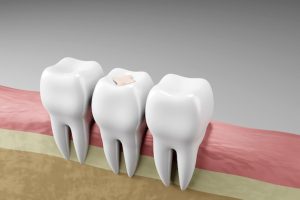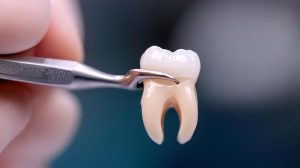As a parent, witnessing every milestone in your baby’s development is a cherished experience. One such milestone is teething, which marks your baby’s first teeth. While teething in babies is an exciting sign of growth, it can also be challenging for you and your baby.
Understanding the teething process, recognizing the symptoms, and knowing how to soothe your baby can make this phase more manageable. In this article, we will explore everything you need to know about teething in babies, from tooth development stages to effective remedies for easing discomfort.
When Do Babies Start Teething?
Teething in babies is a tedious process. The exact timeline for teething varies in babies, but you can generally expect it to start anywhere between 3 months of age. The first tooth may appear when your baby is 4 to 7 months old.
The first teeth to erupt are usually the two bottom front teeth or central incisors. After 4 to 8 weeks, the upper front teeth, or lateral incisors, erupt, and after about a month, two more teeth in the bottom front appear.
When the front set of teeth is complete, it is time for molars or back teeth to erupt. By their third birthday, your child should have all their 20 primary teeth. If your child’s tooth development is slower than this, consult a pediatric dentist immediately.
To your surprise, some kids are even born with one or two teeth or develop a tooth within a few weeks after birth. Unless these teeth cause trouble or interfere with feeding, it should not be a problem.
What Are the Stages of Teething in Babies?
The process of teething in babies takes place in 5 stages, which can be difficult for both kids and their parents. Knowing what to expect during these stages can help ease the discomfort.
Stage 1 (0-6 months):
Babies are born with 20 primary teeth in their jawbones called “milk teeth.”
Stage 2 (6-8 months):
This is the stage when you may notice the first teeth erupt. The upper and lower front teeth begin to erupt at around six months of age. Before this, the teeth may push against the gums and cause the baby to chew toys, hands, or other solid objects.

Stage 3 (10-14 months):
This is when you may start noticing teething symptoms. The primary molars emerge in the lower back and upper jaws. Babies may experience loss of appetite, fever, and diarrhea. Their sleep cycle may also be disturbed due to pain. If you notice severe pain and discomfort, consult your doctor immediately.
Stage 4 (16-22 months):
This is the stage of canine teeth development; your baby would be moderately uncomfortable.
Stage 5 (25-33 months):
Teething symptoms peak during this stage for many babies due to the molars. Since molars are the most prominent teeth, the usual soothing techniques may not work. During this stage, you can probably give them a tricky vegetable to chew on, which is also a healthy option.
What Are the Signs of Teething?
A common sign of teething in babies is an increase in saliva production. You may notice your baby drool more and want to chew on solid things. For many babies, teething may not even show symptoms, while others may show a wide variety of symptoms, such as irritability or crankiness.
Teething Symptoms
The common symptoms in babies include:
- Tender gums
- Swelling in gums
- Excessive drooling
- Slight coughing
- Fussiness and crying
- Tendency to chew on things
- Changes in sleeping pattern
Although teething symptoms are common, these can also make your baby sick with fever, diarrhea, and vomiting. If you notice such symptoms, call your doctor immediately.

Newborn Teething Pain Relief
You cannot wholly avoid teething troubles in your babies. You can, however, help them in managing these symptoms:
- Excessive drooling may cause rashes on your baby’s face. Wipe their face often with a clean cloth.
- Rub their gums with a clean finger if your baby is in severe pain.
- Give them something to chew on. Ensure the object is too big to be swallowed.
- Try teething biscuits or frozen food (if your baby has started eating solids).
- Do not use unsafe teething tablets or gels for babies.
Teething Toys
Teething toys are a great way to engage your baby and distract them from the pain. Refrigerated teething toys can also comfort their pain. Cold pacifiers, spoons, clean wet washcloths, or rubber teethers can soothe sore gums. However, avoid teethers filled with liquid as they can leak, and freezable teethers that are too cold or hard for your baby’s mouth.
Conclusion
Teething in babies is uncomfortable. You can, however, ease your baby’s pain by understanding his symptoms and distracting them with teething toys. As teething brings a significant change, ensuring the good health of baby teeth is essential. You can start oral hygiene practices even before your baby has teeth. This will ensure your baby’s oral health is checked before their teeth develop.
Schedule Your Baby’s Dental Checkup Today!
If your baby is showing symptoms of teething and you wish to consult a pediatric dentist, you can visit us at University Ave Dental.
Call us today at 763-783-1242 to schedule an appointment with us!



